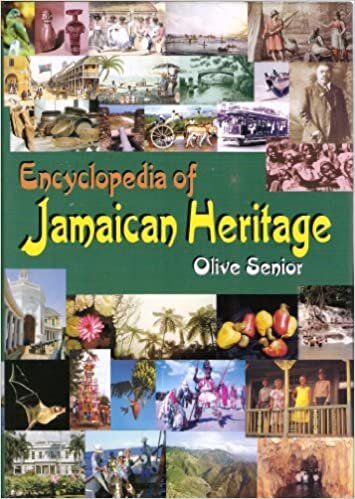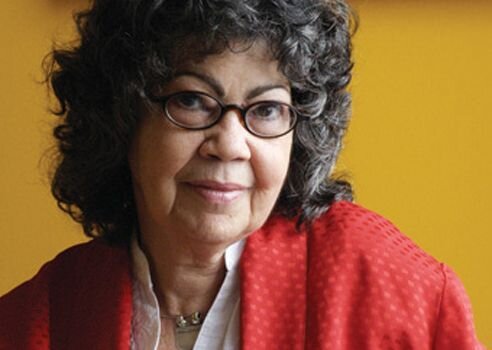Olive Senior's Magnificent Encyclopedia of Jamaican Heritage
Olive Senior’s Magnificent
Encylopedia of Jamaican Heritage
I picked up my copy of Olive Senior’s Encyclopedia of Jamaican Heritage on my way to visit a friend for dinner. After dessert, I pulled the large, colourful volume from my bag. My friend, a Canadian of Jamaican descent, turned the pages ecstatically. “Look,” he said, flipping to the D’s. “She’s got a definition in here for dokunu (a traditional Jamaican pudding) and dominoes. There’s even one for duppy (a restless ghost),” he said laughing. “Can I keep this book for the weekend?”
His enthusiasm is typical of the response the encyclopedia has been enjoying since its release. “One of the things that has pleased me,” says Ms. Senior, a local writer best known for her poetry and story collections, “is that wherever Jamaicans in Toronto have seen the book, they have been very excited. There is the recognition factor, which they enjoy, but they also like learning new and interesting things about the island. That is the reason I wanted to write the book.”
Ms. Senior spent 20 years working on the 547 page volume, which includes more than 1,000 entries and 840 drawings and photographs. The project began as an attempt to update an earlier work, the A-Z of Jamaican Heritage which was published in 1983, but her stack of information kept growing. “I began to realize I was writing something much more ambitious,” Ms. Senior says. The topics are wide-ranging, divulging the cultural history of everything from codfish and the island’s Ibo slaves (Africans who were stolen as free labour), to the practice of Obeah, to such quotidian pastimes as the traditional methods of laundering clothes.
Blue Mountain, Jamaica
Ms. Senior who moved to Canada from Jamaica in 1986, worked on the project between publishing stories and doing teaching stints abroad. “It came to the point where it was taking over my life, and I said, ‘I have to get it done,’ ” she recalls. “But it took so long, because every time I would tell my editor, “Okay, it’s finished,’ I would find two or three more essential things to include. I knew it was really finished when I stopped waking up in the middle of the night thinking about what I might add.”
Now she hopes it will find its way into Toronto’s schools and libraries. At the Maria A. Shchuka Library at Dufferin and Eglinton West in the heart of Little Jamaica, the encyclopedia will be a centrepiece of the branch’s Black and Caribbean Heritage Collection. “It is important to me that children of Jamaican and Caribbean ancestry find themselves in this book,” Ms. Senior says, “because such an encounter will contribute to their sense of being rooted in history.”
Before immigrating to Canada, she worked as a reporter for the Jamaica Gleaner, covering a variety of beats, including politics and the arts. By the time she arrived in Ottawa on a scholarship to study journalism at Carleton University, she already had several years of news experience under her belt.
Olive Senior
She began writing her first short stories while studying at Carleton – a handful are included in Summer Lightning, a collection that earned her the inaugural Commonwealth Writers’ Prize in 1987- and her lyricism and gift for storytelling enrich the encyclopedia. An example from the entry for Mango: “Mango season, in the mid-summer months is eagerly awaited by all. Numerous varieties of the fruit are to be found, each differing according to size, colour, taste, shape, texture, etc. The varieties Bombay, Julie or St. Julian and East Indian are regarded as superior, ‘mi mamma did a tell me nuh fi go mango walk/fe tief out the number leven’ is a folk song which refers to the popular variety called Number Eleven.”
Ms. Senior was born the seventh of ten children to a struggling farmer and his wife in the island’s “Cockpit Country,” a region she describes in the encyclopedia as one of Jamaica’s “least hospitable…an eerie and unusual landscape of steep-sided valleys that alternate with conical hillocks to form a peculiar terrain.” She recognizes that the younger generation of Jamaicans, both at home and abroad, will never enjoy the sights and sounds and traditions of the Jamaica she once knew. Indeed, in a way, that island no longer exists.
Old Harbour, Jamaica
That’s why it was so important for her to fill the encyclopedia with drawings and photographs. “The pictures are an integral part of the book,” she says. “They were chosen to extend the story. A lot of things were hard to get, but I really felt it was important to show kids what things looked like. For instance, when I was growing up there were animal-powered sugar mills…thousands of them throughout rural Jamaica. It was very important to me to find a picture of a sugar mill so children would know what they looked like.”
Ms. Senor’s ultimate objective is to give the encyclopedia’s readers a complex picture of her beloved country: “Jamaica, like all Caribbean islands, is often seen as a paradise or a form of hell. It is not seen as a real place. I am writing the real place. That’s my life imperative.”
From What’s a Black To Do II








